by Winding Pathways | Jul 25, 2024 | Nature, Travel/Columns, Water Resources
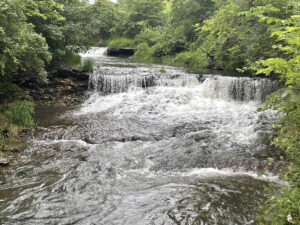
Tumbling waters
There it is! A Waterfall. There’s a second. Wow, just upstream is a third. Three waterfalls in one Iowa stretch of stream! How can that be in such a flat state?
Waterfalls bring mental images of water tumbling down steep hillsides where it plunges hundreds of feet downward. We’ve marveled at tall falls in many states including Hawaii, Nebraska, Washington, Indiana, Minnesota, New Hampshire, and New Jersey. But Rich had discovered the waterfall trio in an unexpected state – Iowa – and in an equally unexpected part of the state.
-
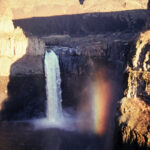
-
Water tumbles through a narrow cataract.
-
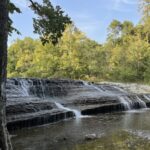
-
Indiana surprise
-
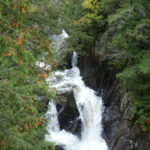
-
North Shore Falls
Briggs Woods County Park Delight
Amid north central Iowa’s vast level corn and bean fields he discovered the three cascades after a short hike near Webster City. More than rushing water caught his eyes. Fish were trying to leap up the rushing torrent. “It brought back memories of salmon leaping Brooks Falls in Alaska. These were small fish of an unknown species. Watching them was great fun,” he said. The three falls are close together in Hamilton County’s Briggs Woods Park and all it takes to enjoy them is a short hike on an easy trail.
Driftless Area
Iowa isn’t flat. Mostly it’s rolling terrain, but the state’s northeast corner features downright steep slopes. It’s the Driftless area, where most of Iowa’s falls gurgle and tumble down into clear running trout streams.
Touring Iowa’s Waterfalls
Seeing the Briggs Woods falls gave us a waterfall bug, so a few weeks later we drove north from our Cedar Rapids home. A region of Karst topography, the Driftless boasts dozens of clear water trout streams and several impressive falls.
-
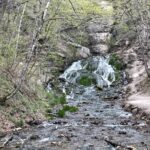
-
Karst topography helps create waterfalls.
-
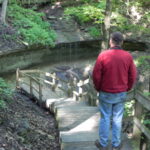
-
Bridal veil falls, at Pikes Peak
Decorah Area
Decorah is Iowa’s waterfall epicenter. Twin Springs bubbles quietly from the ground and flows down past a campground. Siewer’s and Dunnings Springs hurl an impressive amount of cool clear water over rocks close to downtown. (Note, the travel Iowa site uses an apostrophe (‘) for Siewer’s Spring but not for Dunnings). It’s easy to park close to all of these. Viewing nearby Malanaphy Springs is worth the mile walk. It’s the best known of several falls that send water to the Upper Iowa River.
-

-
Cooling waters.
-

-
Water tumbles from the ledges
-
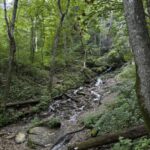
-
A popular stop for canoeists on the Upper Iowa River.
-
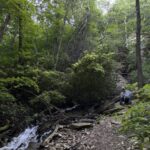
-
Hike through quiet woods.
Other Waterfalls
Other Waterfalls? Yup. Depending on who you ask and what you consider a waterfall, the Hawkeye state has dozens of them. Many aren’t natural waterfalls. Many are human-made cascades tumbling down a dam spillway, but the ones mentioned above are genuine nature-made falls.
Benefits of Seeking Out Waterfalls
We love falls for their beauty. Visiting them has a side benefit. They are in Iowa’s most beautiful terrain. A waterfall viewing trip gives the opportunity to see these unexpected Iowa sights, hike challenging trails, enjoy local eateries, and overnight in nearby campgrounds or one of the dozens of bed and breakfasts scattered about rural and small-town Iowa.
Where to Find Waterfalls
A helpful resource for finding falls is Travel Iowa – 14 Wonderful Waterfalls in Iowa.
by Winding Pathways | Jul 11, 2024 | Nature, Travel/Columns, Wonderment
Winding Pathways is near the edge of town, making it easy to drive into the country and enjoy rural views. Mostly our car traverses Iowa’s abundant corn and soybean fields, but two recent trips gave exceptional views of different vegetation that bloomed in bright lavender under the June sun.
The Lavender Farm
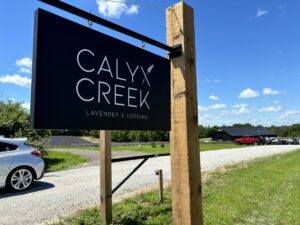
Entry to Calyx Creek
One recent June afternoon as we drove through conventional crops an amazing and delightful view appeared. Shades of purple and stunning white blanketed the undulating land accenting the deep green of cultivated crops. We had discovered Calyx Creek Lavender and Lodging a few miles west of North Liberty, Iowa. Rows of lavender in various stages of growth surrounded us as we entered the main building to find various products made of this unusual plant.
The warm, calming fragrance of the oils of this subtle herb wafted through the shop. Dried bunches hung from racks. Informational signs in front of gleaming machines shared highlights of the distillation process. Soaps, oils, candles, carpet freshener, lavender-infused stuffies and slippers, beverages, and tasty treats beckoned visitors to sample and buy. A lemonade mix was a hit among patrons on this warm summer day. “It smells so good inside, and this lemonade is super!” commented one man, cupping the cool drink in his hands.
-

-
An array of products awaits.
-

-
Slushys are popular.
Tours and Lodging
Part of the experience includes tours, opportunities to harvest and enjoy in your own home, and overnight lodging!
We walked among fields of blooming lavender to two of the several cabins available for rent. The two, built on pedestals, are well-equipped. All the lodgings offer a chance to “get away” while being close to nature. We climbed the stairs, sat on the small cabin’s deck, and took in the rural views of expansive fields of lavender. Peace flowed through us.
-
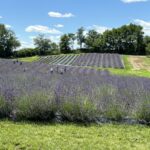
-
Strolling through lavender fields
-
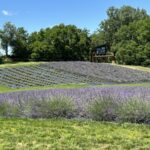
-
Peaceful overnights
Calyx Creek Lavender and Lodging is a fun place to visit, especially during the early summer blooming time. More information at: Calyx Creek LLC, 1722 255th St. NW, Oxford, IA 52322.
Phone: (319) 900-5992
Where Does Lavender Originate?
Lavender is native to the Mediterranean Region of southern Europe and Northern Africa. It has so many uses that it has been planted around the world. It has become problematic in Australia but is a valued product in North America. Lavender has a long, documented, and storied history with applications for improved health, reducing anxiety, moderating the effects of bug bites and burns, and as an antiseptic/anti-inflammatory agent. The latter is useful in the flu season. Gardeners can grow lavender at home. A helpful resource on how to grow it is at Garden Design.
More Rural Views
The fields of lavender at Calyx Creek are carefully groomed, providing a contrast to our discovery the next day. Secondary roads stairstep through Iowa, replete with rural views of corn, beans, oats, cattle, and goats. We were making our way to a reconstructed prairie south of Waterloo, Iowa
The Irvine Prairie
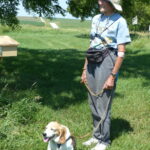
A happy duo.
That day Cathy Irvine led us through her prairie dotted with pale purple coneflowers, purple prairie clover, and blooms of different hues. Common yellowthroats serenaded us as red-winged blackbirds winged around this amazing place.
We admired the beauty of one of Iowa’s largest reconstructed prairies and were humbled to have Cathy Irvine share part of her day with us. Some people are so inspiring. She’s one.
After years of conventional farming, her vision took her land in a different direction. She’d turn the clock back and restore her land to how it looked and functioned before the first plow turned the original prairie into row crops. She didn’t do this on a whim. For decades Cathy had thought about, researched, attended programs on, and connected with experts on prairies. She knew that reconstructing the native habitat with its diverse plants and animals was right to do.
-
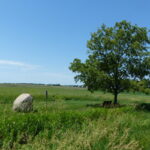
-
Glacial boulders are part of the landscape.
-
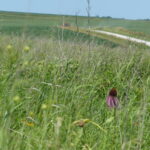
-
Contrast
Collaboration
Working with the Iowa Natural Heritage Foundation and the University of Northern Iowa Tallgrass Prairie Center she placed much of her farm in conservation easement and collaborated on restoring it to its native vegetation in honor of her late husband, David. Being in a conservation easement means that it will remain a wild and gorgeous prairie forever, no matter who might own the land in the future.
Iowa’s Rich Heritage
Iowa’s original prairie hosted upwards of 300 plant species on each acre that agriculture transformed into vast monocultures of soybeans and corn. Cathy’s land was in row crops until she decided to give her property to the Tallgrass Prairie Center under a conservation easement. Starting in 2018 the Prairie Center began planting upwards of 100 native species an acre and followed it up with prescribed burning, weeding, and even plugging in more native species.
Cathy, the Tallgrass Prairie Center, and the Iowa Natural Heritage Foundation welcome visitors to experience what much of Iowa once looked like. It’s a place to enjoy dancing prairie grasses and forbs on a breezy summer day, listen to birds trilling across the expanse, watch butterflies forage on blooms, and be inspired by the quiet beauty resulting from a transformation springing from Cathy’s vision and cooperative effort.
The Prairie is located at 1173 55th Street, Dysart, Iowa. Several mowed trails radiate outward from a small parking lot. A bench nestled under a spreading tree offers shade and a place to reflect.
-
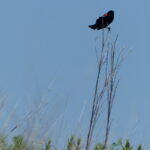
-
Calling out territory
-
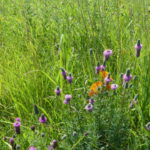
-
colorful forbs
-
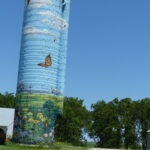
-
Colorful silo
Best Times To Enjoy Prairie Flowers
Prairie flowers bloom throughout the growing season but during midsummer’s heat, the colors are most amazing. However, the prairie is magical in any season. We enjoy our small reconstructed prairies through all seasons and especially in the summer months.
The Lavender Farm meticulously cultivates a useful plant not native to Iowa and the Irvine Prairie carefully stewards a rewilded prairie. Both are gorgeous.
For more information, visit the Tallgrass Prairie Center and the Iowa Natural Heritage Foundation websites.
The Color Purple
Our eyes had the good fortune to view purple lavender one day and purple prairie flowers the next, but purple is a tricky color, at least for some people. Like around 10% of men and boys, Rich isn’t able to see it or see it as folks with normal color vision can. “Red and shades of red are hard for me to see. Purple is nearly impossible. It seems odd but I can see the color but know it looks very different to me than to most folks. If someone asks me what purple looks like I have to say, I’m not sure since I can’t really see it,” he said. “Fortunately I can see blue and yellow prairie blooms and magnificent butterfly milkweed flowers that seem to glow a bright orange,” he added.
Winding Pathways encourages readers to take in any of their native habitat to appreciate our green island home – Earth.
by Winding Pathways | Jul 4, 2024 | (Sub)Urban Homesteading, Bugs, Garden/Yard, Garden/Yard, Nature
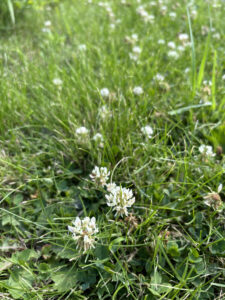
Mowers pass over low-growing clovers.
We recently discovered an amusing irony created by one of the most common lawn plants – white clover.
Sometimes called Dutch Clover, this low-growing plant graces unsprayed lawns in temperate regions across the globe. Normally, we discourage nonnative plants at Winding Pathways, but clover is an exception.
Although native to Eurasia, it’s not invasive. This important forage legume is likely the most widespread in the world. Diminutive clover is so low growing our mower passes right over its dainty flowers. Our friendly cottontail bunnies may seem to be eating grass, but actually, they’re feasting on clover. So are beneficial insects. As its flowers add beauty to the lawn and feed animals, clover’s roots pump nitrogen into the soil, helping other plants grow.
The irony
AI detected our Internet search for clover information. We began getting computer ads from landscaping companies encouraging us to hire them to kill our clover “and other weeds” in our lawn. No way!
Many people spend good money to poison beneficial lawn plants. They expose themselves, their pets, and anyone who walks on the lawn to toxic substances.
Maintaining a Healthy Bed of White Clover
White clover tends to gradually decline over the years. We’ve noticed this at Winding Pathways. To give it a boost we buy white clover seeds and sprinkle them on the lawn during cool months, especially on bare spots. Seed can be purchased online and in stores where hunters shop. These stores sell seeds beneficial to wildlife, and hunters often plant them to boost food for deer and wild turkeys.
-
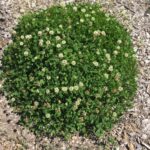
-
Clover can be manicured.
-
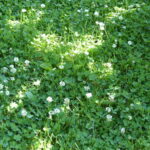
-
Sunlight on a clover lawn forms a cross.
-
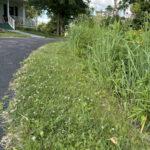
-
Dutch White Clover is low-growing.
Rewards
We have healthy lawns, rich with nitrogen. And, on summer mornings and evenings, we sit in our front porch’s rocking chairs watching bumble bees and bunnies foraging on our blooming white clovers. Thanks, clover.
-
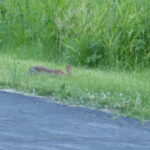
-
Bunnies enjoy clover.
-
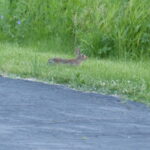
-
Watchful
by Winding Pathways | Jun 27, 2024 | Nature, Trees/Shrubs
This is a story of the serendipity of giant trees. On a recent long drive to New Jersey, we planned to visit a grove of giant white pine trees in Pennsylvania’s Cook Forest State Park. Plans don’t always go perfectly, but sometimes serendipity happens. It sure did for us.
We are awestruck by the beauty and heritage of giant trees and found an exceptional one by accident. Serendipity. About a hundred miles after we left home, we needed to change drivers and exited Interstate 80 Eastbound just after crossing the Mississippi River.
Rest Stop Serendipity
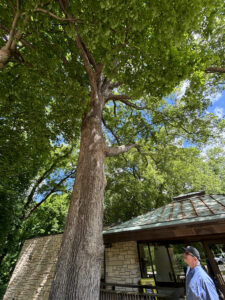
Welcoming Oak
We planned to make a brief stop but stayed a while to marvel at a massive white oak that greeted us at the building’s entrance. We marveled at its girth and spreading limbs. The people who designed and built the restroom structure took pains to carefully craft it to emphasize the tree’s beauty and protect it from construction damage.
This tree is worth a stop. It is at about I-80’s exit one in Illinois immediately south of the Mississippi River. There’s also a magnificent view of the River and Iowa in the distance.
Pennsylvania Wilds Serendipity
We’d checked Pennsylvania’s predicted weather before leaving our Iowa home, and it promised pleasant camping weather in Cook Forest State Park. Our camping gear was in the car as we headed East. Well, weather reports aren’t perfect. Crossing Ohio in driving rain we realized that being in a tent that night would be soggy, but serendipity happened. Our cell phones helped us book an overnight room at a lodge near the Park’s ancient pine grove.
In the rain, we took small twisty roads for about 20 miles north of Clarion, Pennsylvania.
It was still cascading down as we entered the vast park in the midst of THE PENNSYLVANIA WILDS. We’d come a long way and were determined to see the grove of ancients, so, raincoat-clad, we headed up the trail.
Cook State Forest Serendipity
It was magical. We were enveloped in a forest of massive pines that had sprouted around 1600 and bypassed by the loggers who leveled most of the Keystone State’s forests. Beneath the trees, the ground was soft as a plush carpet. Other than raindrops, silence enveloped us – a soothing respite from the Interstate’s noisy trucks.
Cook Forest State Park is set in a vast woodland along the Clarion River. Only a few miles north of Interstate 80, it offers hiking, mountain biking, fishing, hunting, river running, and enjoying massive trees. Many area cabins and lodges offer dry places to overnight, and the Park has a campground. Serendipity met us again.
-
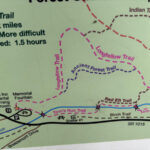
-
Map guidance
-
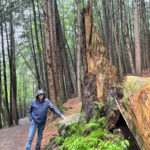
-
Giant forest
-
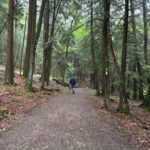
-
Walking in the rain
Clarion River Lodge Serendipity
Wet and soggy after our forest walk, and tired of twisty roads, we found ourselves at the Clarion River Lodge near the grove where Shannon Otte warmly greeted us. She showed us our cozy, dry room. Later we enjoyed dinner while watching the rain continue to drench the woods.
-
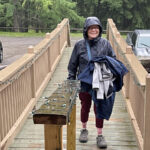
-
We arrived soaked…
-
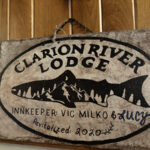
-
Rustic and comfy.
-
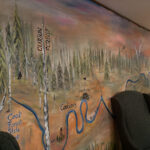
-
One of the warm features of The Clarion Lodge.
Fortunately, the rain slowed, giving us a chance to walk a gravel road above the lodge. Ovenbirds serenaded us from deep in the forest as we overlooked the Clarion River.
The Clarion River Lodge is a revitalized lodge with distinctive rooms creatively well-appointed. The dining area and bar welcome guests and locals. The entire establishment, tucked into the woods is cozy and comfortable. The mix of vintage and modern make for great exploring of the common room and the halls, and peeking into different rooms.
-
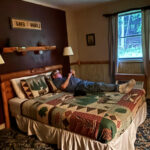
-
Beautiful Quilt
-
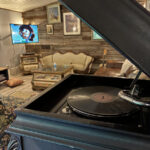
-
A blend of old and new.
-

-
The Throwback Record Room
-

-
Light and Airy
The next morning, we took advantage of the coffee maker in the lobby and enjoyed the view of the woods and moss-covered rocks from the end of the second-floor hall porch. A phoebe scolded us as we sat sipping our warm beverage. When we realized we were settled near its nest we moved further away. Under a clear blue sky and waning crescent moon, we enjoyed the soft drip of last night’s rain off the trees.
-
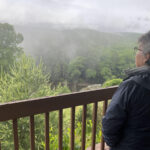
-
Visitors can enjoy several types of lodging in the Pennsylvania Wilds
-
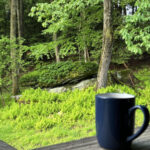
-
A quiet interlude
-
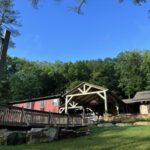
-
Sparkling after the rain.
Overall the drive East was filled with Giant Trees that enticed us to stop.
Finding Giant Trees
American Forests keeps a list of the biggest known individual of nearly all species of North American Trees. The registry helps anyone locate these giant and, often, ancient trees.
by Winding Pathways | Jun 20, 2024 | (Sub)Urban Homesteading, Energy Efficiency, Nature, Trees
Connecting With Wood
Although we rarely watch sports on TV, the 2024 Iowa Women’s Basketball team captivated us. With athletic sneakers squeaking up and down the wood floor, Caitlin Clark’s sharpshooting and Hanna Stuelke’s blocks were amazing.
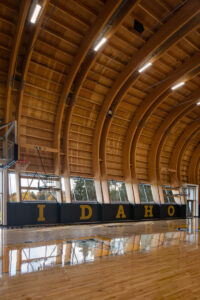
ICCU Arena Photography by Lara Swimmer. Images use restricted. Use by permission only.
About a month after the season, we entered an elite new basketball arena. Neither Caitlin nor Hanna was there, but we bet they’d love playing in a gorgeous new venue crafted mostly of wood. It’s on the University of Idaho campus.
“The arched ceiling beams are strong, beautiful, and crafted of local Douglas Fir and larch,” said Dean of the University’s College of Natural Resources, Dennis Becker, as he guided us through the University’s Idaho Central Credit Union (ICCU) Arena. It opened in October 2021 after about two years of construction and several more of planning and fundraising. Remember, this was during the Pandemic!
Modern, Flexible, and Beautiful Venue
After playing in the nearly century-old Memorial Gym and a few years in the massive Kibbe Football Dome, the University sought to create a gorgeous and flexible venue that enabled players and spectators to enjoy the intimacy of a largely wooden building that connects spectators with nature. Building it drew on the college’s academic strengths in forestry and wood technology, architecture, engineering, and athletics.
“Much of the wood used to create it came from the University’s Experimental Forest. In addition to being elegant its beams of laminated wood are sturdy, fire resistant, and gorgeous,” continued Dean Becker.
-
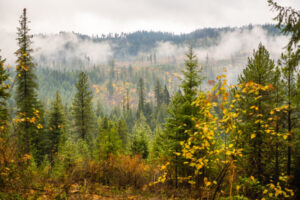
-
Logging and Maintenance at the Experimental Forest
-
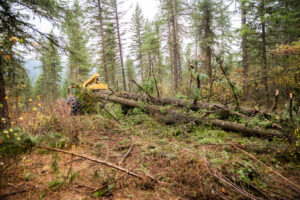
-
Selective logging
The Dean later explained that the reason the building feels warm and comfortable may be a concept expressed by Erich Fromm to describe the biological orientation humans have with all that’s alive and vital. Biophilia was expressed by the late Harvard professor E.O. Wilson as an affiliation people have with other life forms and nature as a whole, which is rooted in our biology.
-
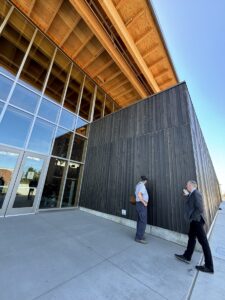
-
Gorgeous and modern
-

-
Courtside in background
-
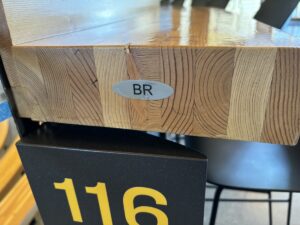
-
Variety of woods
Connecting to Wood
Perhaps biophilia made us feel comfortable immediately after entering the Arena as it does in our Iowa home. In both places, we enjoy being enveloped in wood.
We recently visited friends in their brand-new home. Although functional and low maintenance, something about it was mildly uncomfortable. Crafted almost entirely of human-made products the home had doors of plastic, flooring of artificial planking, and walls of plaster. Even the cabinets were plastic. It lacked wood.
In contrast, our 1947-era home replete with wood feels cozy. Floors are white oak and Douglas fir with beams and rafters of pine, fir, and cedar. Our tables were crafted from red oak and black walnut and on the fireplace mantle is a polished cross-section of an oak crotch and a leaf carved from silver maple wood.
What Is It About Wood?
We love wood. It’s gorgeously individualistic. No two boards are exactly the same. It projects a warm and comforting feeling while having environmental benefits. Sustainably managed forests allow land to continually produce wood forever. It is also easy to reuse or repurpose.
Last winter we hired a company to refurbish our downstairs bathroom of easy-to-clean plastic and vinyl. It functions well, but something about it didn’t feel right. No wood. So, Rich bought a half-inch thick oak board, cut it to fit, finished it with a soft finish, and nailed it to a ceiling beam. That single piece of wood made the bathroom more comfortable.
Whether in a home or the University of Idaho’s Idaho Central Credit Union Arena, the beauty and function of wood make us feel at home.
-
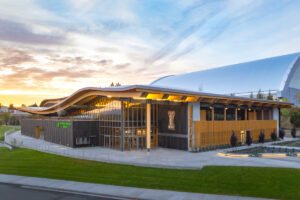
-
ICCU Arena exterior drone shots
-
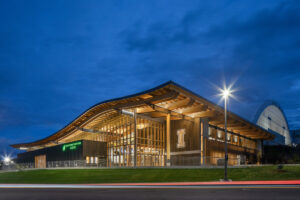
-
ICCU Arena photography by Lara Swimmer. Images use restricted. Use by permission only.
This is one of a three-part series of blogs stemming from a recent visit to our alma mater, the University of Idaho. The school offers an array of majors and is located in the rolling farmland of the Palouse and nestled below Moscow Mountain. For information check out uidaho.edu. Its College of Natural Resources offers majors ranging from wildlife biology to outdoor recreation, and forestry. It’s where Rich graduated. Marion received her MS from the Idaho College of Education, which features a variety of degrees, including movement science.
by Winding Pathways | Jun 13, 2024 | Nature
Smoke Gets In Our Eyes
We sat on our deck on a June 2024 evening and breathed air carrying the season’s first waves of smoke wafting from Canadian fires. Last summer the smoke was so thick visibility shrank to less than a mile. We don’t remember such thick smoke in the past. What’s going on?
-
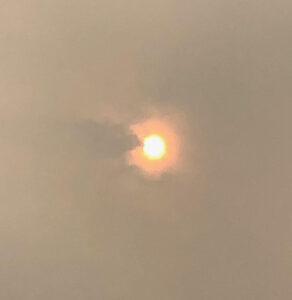
-
Thick smoke obscures the sun.
-

-
Smoke drifts
The answer is. Lots!. Here’s a brief fire history and our half-century involvement with fire and smoke.
Fire’s Cultural History
Indigenous People and Fire
If we sat where our house now stands a thousand years ago, we’d likely have seen smoke. Native Americans routinely set fires that burned through grasslands and forests. Fires transformed the landscape by stimulating grass, killing brush, and favoring fire-resistant plants. In many areas burns prevented the formation of dense woods. Instead, the fire created savannas, widely spaced big trees that towered over soil clothed with grasses, wildflowers, and sedges. These ground-hugging plants nourished bison and elk that provided human food. Shrubs were rare, giving the forest a feeling of “openness”. Fires were an integral part of Native American culture, forming the landscape early Europeans discovered when their sailing ships made landfall.
Europeans and Fire
European culture viewed fire differently. It was considered destructive and wasteful. From early settlement days until relatively recently people eagerly extinguished fires. Aversion to fire became government policy, birthed Smokey Bear, and began the Patterson’s fire journey.
An Idaho Fire
Fifty years ago, Rich was armed with a chainsaw on a high ridge in the Boise National Forest. As fellow crewmates hastily scratched a fire line Rich felled trees downhill toward flames galloping uphill. Hopefully, their fire line would stop the inferno. Help came from above. A noisy slurry bomber dropped fire retardant along the new fire line. It worked! As the fire reached the line it halted.
We were on that smokey ridge because of the Forest Service’s “10 a.m. policy”, which stated that all wildfires would be extinguished by the next morning. The old rule once made sense to a fire-averse culture that didn’t understand fire ecology.
Today’s Wildfires Management
Gradually the science of fire ecology emerged to help us understand the critical role flames play in ecosystem health. The old “10 a.m. rule” is now history, and today’s land managers set prescribed burns. Why?
Well, Rich has personal experience. In 1989 he set a fire in the Indian Creek Nature Center’s oak woodland. “Fire killed understory shrubs of mostly invasive exotic species and stimulated long suppressed sedges, grasses, and wildflowers. After a few years light-demanding young oaks sprouted under the rather open canopy of parent trees.”
How Periodic Fires Help
Periodic fires sort vegetation by retarding plants sensitive to burns while encouraging resistant ones. Low-intensity periodic fires also burn fallen branches and other fuel that, if left unburned, accumulates to enable a future more intensive burn.
-
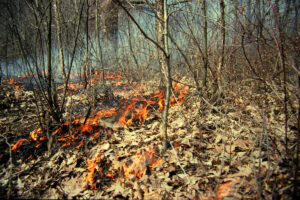
-
Careful burning of woodlands
-
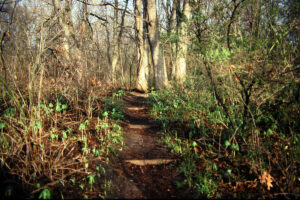
-
Fires help understory
Our Continued Fire Bias
Americans will see examples of fire bias on the nightly TV news this summer. Reporters flock to big fires, especially in the West. They’ll show the charred and smoking remains of a fire and say, “Over 120,000 acres of forest were destroyed this week”. Well, no. Fires, don’t destroy forests. They change and often invigorate them. Fires are a natural form of land disturbance that many plants need to thrive. Journalism fails by not returning to a burn site a few years later to show a verdant growth of new trees…..it’s the rest of the story that many Americans don’t understand.
So Why So Many Fires and So Much Smoke Now
We’re breathing wildfire smoke for two significant reasons. One is our old fire bias.
For a century we’ve done such a good job suppressing fire that forests are choked with dead fallen branches and tangles of small trees that feed hot and intense burns. These hot fires can kill mature trees and spew forth an abundance of smoke. Social bias created these tinderbox woods.
Then there’s climate change. Ecosystems are hotter, dryer, wetter, soggier, and windier. A forest suffering through unprecedented hot drought and overstocked with fuel is a recipe for burns big enough to envelop much of the continent in smoke. According to the University of Idaho’s Dr. Leda N. Kobziar climate change is increasing the availability of fuel, like deep organic soils in northern Canada that now burn.
What is In Smoke?
Is that smoke bad? Well, maybe, and maybe not. Smoking cigarettes causes health issues. Wildfire smoke isn’t as intense or prolonged as that which directly enters the lungs from a cigarette but it can cause breathing problems. Breathing smoky air isn’t healthy.
Research Points the Way
Smoke may have benefits. Dr. Kobziar’s research is investigating the impacts of fire that are beyond the visible. It’s easy to see the physical changes that a burn causes, like Rich’s observation of enhanced wildflower abundance after a burn at the Nature Center. Dr. Kobziar’s team has found that within millions of floating smoke particles is a host of microbes. Microbes! Sounds bad, but these aren’t always tiny creatures that infect people. Smoke transports beneficial microbes that help enhance the health of forest soils but can also move fungi that can infect people. “There’s a lot yet to learn,” said Dr. Kobziar. To read more about this fascinating concept visit.
Managers of grasslands and forests now often set prescribed burns to consume fuel and increase ecosystem health. Normally prescribed burns are held at times and under weather conditions that produce less smoke than wildfires.
-
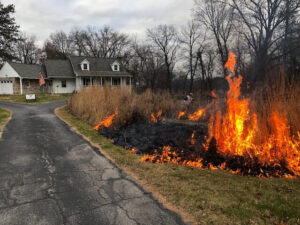
-
Regenerating the labyrinth
-
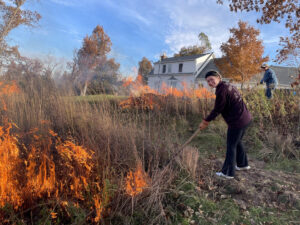
-
workers pull fire along to set other areas ablaze.
-
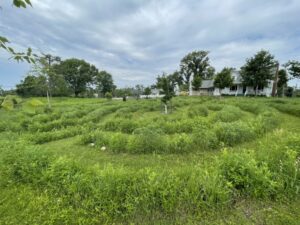
-
Ready for summer’s fullness.
-
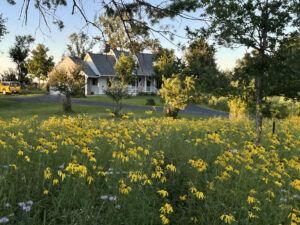
-
Brilliant flowers
Upshot
It looks like we’re up for a smoky summer. It’s understandable why the woods, and even the soil, are burning and spewing forth clouds of smoke.
This is one of three blogs stemming from our recent visit to our alma mater, the University of Idaho. This outstanding college offers, among others, majors in natural science, education, and architecture.

























































